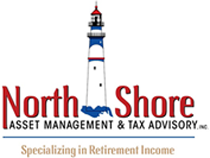Retirement & Income Planning
North Shore Asset Management & Tax Advisory – Retirement & Income Planning
Retirement planning is done by many, but not by all. Retirement defined is finishing your life’s work. Or perhaps reducing your involvement, leaving your job if you have a job or profession, and relying on your assets to produce income for yourself and your family. The key is to plan ahead and make sure there are enough resources to provide more stable and predictable income for the remaining years of a retiree’s life. In essence, we would want enough income to cover the foreseeable living expenses for lifetime enjoyment and needs. It requires a review of assets, of course. And how much in resource is necessary to help generate that income in retirement.
The process for retirement planning begins with a discussion of goals, primarily when retirement would begin and if we’re dealing with a married couple, it would be a question of do both spouses retire or does one? Does the retirement occur at different times or years? But it starts out with timing. Then we would address the subject of the desired level of retirement income. Some people like to retire prior to eligibility for full Social Security retirement or the available of a pension if there is one or others will choose to retire once they have achieved the full retirement benefit which is currently age 67 or perhaps waiting until 70 for that and any pension availability if there is such a thing. And we would look at those resources and compare them to the costs of living. Everything including things like housing, medical, automotive, leisure, food and other normal expenditures or planned expenditures. Often people plan to pay for weddings, vacations, the acquisition of a second home, things of that nature are also among objectives that our clients have. We would then go through a process of what we call a gap analysis which means comparing the availability of income resources to the desired amount of income in retirement. We would then look at other sources, such as 401(k) or Thrift Savings Plan balances and other investment accounts as resources to produce income from those assets as well. We would take any particular gap, if there is one, and engineer a plan to get income from the non-income-producing sources, like 401(k)s and TSPs and other 403(b)s or IRAs or any of those tax-deferred savings plans. We can also use cash if there is a lot of cash in banks as resources to develop a plan to reduce the income that is needed to fill the gap between income resources and the desired income goal. We would talk about risk tolerance and the need for liquidity.
We have encountered a number of people who just simply retire when they want to, without much regard for planning their income. In many cases, people have a lot of stock or other wealth from 401(k) plans, or stock — brokerage accounts, or even large bank accounts. And they look at the size of those accounts and feel safe, in that they will provide income sufficient enough to last the remainder of life. In many cases, other things come up, such as the acquisition of a home, a second home, travel. I’ve also heard that there are three phases to retirement. I’m borrowing this from somebody. But you have the go-go phase, the first 5 to 10 years if you retire, you’re knocking off all the things on your bucket-list. The travel, the acquisition of things, having fun, seeing the children and grandchildren are provided for, first homes, educations, and so forth. And then after that, there’s a so-called, slow-go phase where you’re not traveling as much. All the basic acquisitions you planned are accomplished. And you now are enjoying your income, but not as active as you were during the go-go phase. You will still enjoy your leisure activities, perhaps things like golf, fishing, and other things like that. Then in a person’s age group of late 70s, 80s, and even 90s, we enter the no-go phase. Meaning, you really don’t feel like traveling much. Although activities are reduced, the need for stable consistent income is not any less important.
During this no-go phase, your primary concern tends to be medical care, doctor’s appointments, tests, procedures, and all these things we talk about when we reach that particular age group. Of course, insurance, Medicare, medical supplements, and hopefully long-term care insurance is in place, so that the assets you have accumulated for you living expenses to not have to be consumed for health care. Long-term care, should we need chronic nursing care or live in an assisted living or long-term facility, is a whole different situation where the expenses of living can double or triple depending on the type of care we need and from whom providing that care is provided. Planning for this is an important phase of planning retirement and future income.
